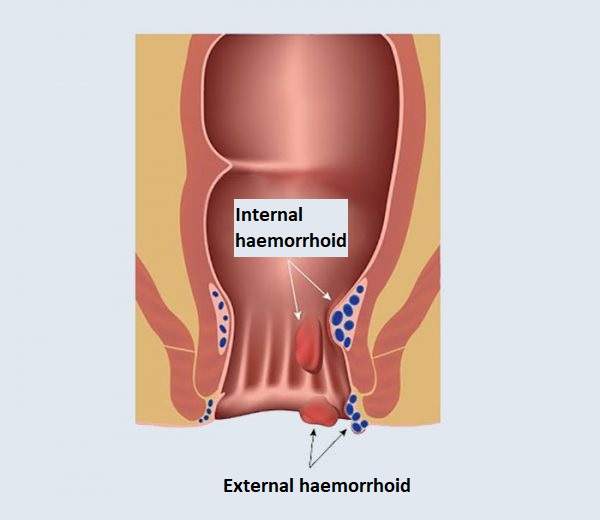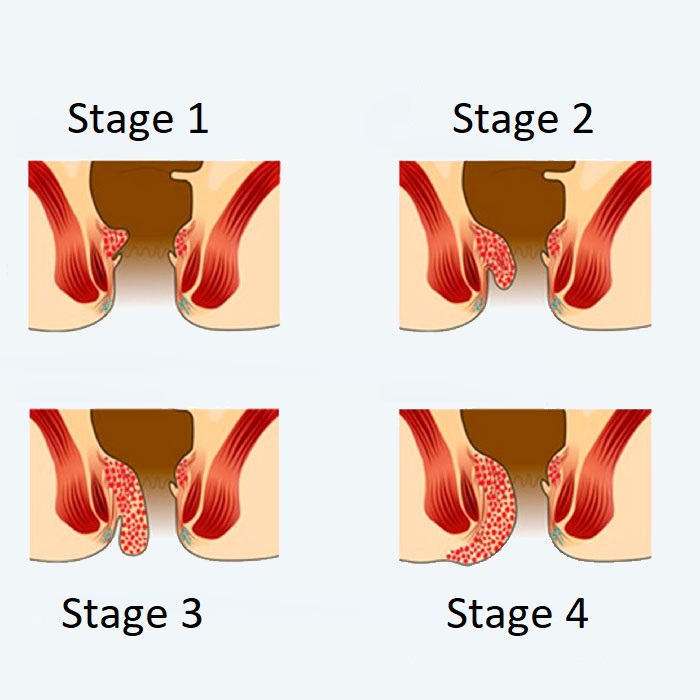Laser haemorrhoid surgery (Laser HaemorrhoidoPexie - LHP)
The LHP procedure allows the treatment of second- and third-degree haemorrhoids in a much gentler way than conventional surgery – especially with regards to pain and missed days from work. With this technique, laser energy is directed into the appropriate hemorrhoidal node, thus sparing the sensitive skin and mucous membrane as much as possible.
There are two types of haemorrhoids, external and internal. While the former are located under the skin surrounding the anus, internal haemorrhoids are located on the inner wall of the rectum. In this case, the haemorrhoids are usually not painful and cannot be felt, but their presence can be inferred from bloody stools. External haemorrhoids are often not only painful, but also cause bloody stools and itching during defecation.
A proctologist can determine the type of haemorrhoid after a colonoscopy.

What are the symptoms and stages of haemorrhoids?
Haemorrhoids are most often indicated by the following symptoms:
- painful defecation
- characteristic streaks of blood on toilet paper
- itching in the anus
- protrusion of hemorrhoidal nodes in an advanced state
- bloody, mucous-stained stool
- long-term constipation
However, it is important to emphasize that the listed symptoms can also occur in the case of other rectal diseases (such as polyps or anal fistulas), so it is recommended to consult a proctologist as soon as possible.
Mi az aranyér és hogyan alakul ki?
Szervezetünk egyik legérzékenyebb régiója az ér- és ideghálózattal átszőtt végbél, melyet nyálkahártya borít. A végbél megfelelő működéséhez és a székletürítéshez elengedhetetlen az ilyen jellegű érpárnázottság stabilitása.
Az aranyér akkor alakul ki, amikor ez az érhálózat kitágul, az érpárnát tartó kötőszövet megnyúlik, az ezáltal elvékonyodó vénák falai pedig sérülékenyebbé válnak. A bennük levő vér súlya miatt kicsúsznak a végbélnyíláson, így az aranyér a végbél záróizmai közé szorul.
In the case of internal haemorrhoids, and taking into account the size and progression of the nodes, we distinguish 4 stages, which, however, do not necessarily reflect the severity of the complaints.
stage 1: bleeding may occur, but the nodes do not fall forward and there is no pain
stage 2: with increased pressure (defecation), the vascular node falls forward, but spontaneously retracts
stage 3: in case of abdominal pressure, when defecating, the nodes fall forward and can only be put back with the help of fingers
stage 4: the veins are broken, emptying them is impossible, acute pain occurs, the hemorrhoidal nodes are excluded
What can cause haemorrhoids?
There can be several triggering factors for haemorrhoids, the most common of which are the following:
- hereditary connective tissue weakness
- straining in case of constipation
- diarrhoea (frequent defecation dilates the veins)
- incorrect, low-fiber diet, obesity (the cause of haemorrhoids is abdominal pressure)
- pregnancy (an enlarged uterus can put pressure on the vascular cushions in the anus)
- a sedentary lifestyle

What do you need to know about laser haemorrhoid surgery?
The procedure is primarily suitable for the treatment of second- and third-degree (stage) haemorrhoids. The homogeneous laser radiation of the LHP® fiber, which is necessary for this process, ensures:
- tissue shrinkage in the hemorrhoidal node
- closure of the arteries supplying the hemorrhoidal node
- maximum preservation of muscle, skin and mucous membrane
- restoration of natural anatomy
The procedure allows laser coagulation of single and multiple hemorrhoidal nodes during one procedure. Controlled delivery of laser energy in the hemorrhoidal cushions causes the nodes to contract. In addition, the connective tissue under the mucosa regains its original position in the rectum. This eliminates prolapse and helps prevent its reappearance, i.e. repeated protrusion through the anus.
What are the advantages of laser haemorrhoid surgery?
Laser haemorrhoid surgery has several advantages over conventional surgery:
- no incontinence, i.e. stool retention disorder
- a 3 mm puncture only in the skin next to the anus
- no foreign bodies (such as rubber or metal clips)
- no risk of stenosis
- the recovery is excellent, because compared to conventional surgeries, there is no incision, only a very small, 3 mm incision in the mucosa, the haemorrhoid is accessed through this small opening
- no stitches
- the procedure does not cause wounds in the anal skin area or inside the anal canal, as a result, the patient has less postoperative pain and the patient can return to work and normal everyday life in a short time
Laser haemorrhoid surgery procedure
During the preoperative consultation, your proctologist will provide detailed information about the necessary tests before the surgery, as well as the course of the surgery and its risks.
The surgery is performed under local anaesthesia, as follows:
- The laser fiber is guided directly into the centre of the hemorrhoidal node under visual control.
- The LHP® laser fiber shrinks the haemorrhoid from the inside out.
- As a result of the treatment, the haemorrhoid shrinks and slowly regresses.
The surgery takes 10-15 minutes. The patient stays in the hospital for an average of 1 day, after which the recovery time is only a few days.
What is included in the price of our surgeries?
- costs of the surgery
- costs of anesthesia (local or general anesthesia, postoperative pain relief)
- the costs of the planned hospital stay and care
- necessary medicines and certain medical aids during the stay
- inpatient physiotherapy treatment (if necessary for rehabilitation)
- if necessary, the fee for the planned histological examination
- the price of the first follow-up examination
What additional costs might be expected?
- implants
- consultation with the anesthesiologist (must be done in Medicover)
- pre-operative examinations (if performed by us)
- in case of blood group antibody positivity, the blood matching fee
- hotel service fee for extra care days
- aids for further rehabilitation
- accompanying person staying in the hospital
- day (with one meal) 20 000 HUF
- night (full board) 60 000 HUF
- furthermore, if necessary, the cost of the 2nd follow-up examination is the fee of the specialist examination -50%, the cost of the 3rd follow-up examination is the fee of the specialist examination -30%
The course of the surgery
Before surgery
- pre-surgery specialist consultation, where the specific surgical proposal is made
- consultation with the Case Manager
- general information if necessary
- preparation of a written quotation
- booking surgery and preliminary examination appointments
- payment
-
carrying out pre-operative examinations
-
arrival for surgery
On the day of surgery
- arrival at Medicover Hospital at 6:30
- check-in at the reception on the ground floor
- occupying a room accompanied by a nurse, who provides information
- morning visit with the specialist physician and anesthesiologist
- surgery
- postoperative monitoring
- afternoon visit with the specialist physician
- constant anesthesiology specialist monitoring in the postoperative period
- discharge (with an accompanying person), final report and handing over a certificate
Surgical service process
- surgery
- hospital stay and care
- planned histology
- follow-up examination, sutur removal
